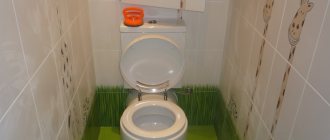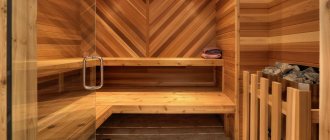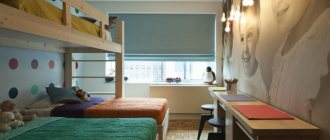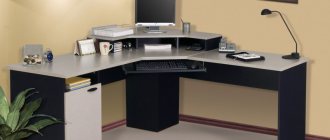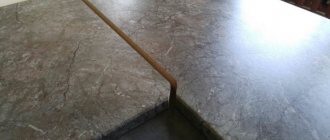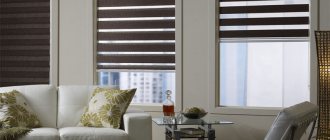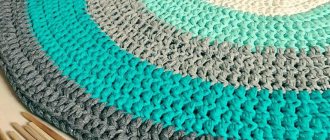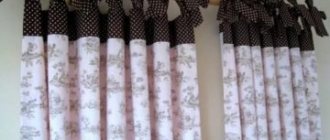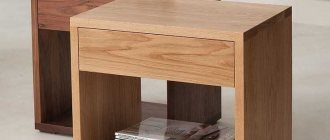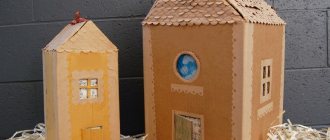A bedside table is an indispensable bedroom furniture. Very often, essential items that may be needed at night are stored in it, and you need to put your phone somewhere so that it is at hand even in the dark. So sometimes it’s quite difficult to do without a cabinet.
Plus, this furniture wonderfully complements the interior and makes it complete and beautiful. You can buy it in a store, but a DIY bedside table is quite simple to make, so you can make it yourself.
DIY bedside table
How to assemble a bedside table? Detailed instructions for the home handyman.
When working with papers at home, and even more so in the office, there is often a need to organize storage for folders, files, and office supplies.
And it often happens that there is simply no room in the room, except in the inner space of the table, for this. A roll-out cabinet with drawers under a desk will help solve the problem. You can, of course, buy a finished product if you can find the right size, or you can, if you wish and have the necessary tools, make it yourself. This is where we will try to help you.
Roll-out cabinet with drawers for desk
End of work
How correctly and accurately the process is performed depends on how smoothly the drawers open and close. To do this, guides are installed on the side surface of the structure. Then they lay plywood and then install guides on it.
At the next stage, the parts of the boxes are connected. They are screwed using self-tapping screws.
When the structure is completely ready, you should check how smoothly the system operates. To do this, open and close each drawer several times. If during operation they jam or move with difficulty, disassemble the structure and try to assemble it again.
At the next stage, use sandpaper to sand the surface well. This will allow you to get a perfectly flat surface.
The product is painted depending on the taste preferences of the homeowner. Also, the decisive point in choosing a coloring composition is what kind of finishing is available in the bedroom. You can make the bedside table a kind of accent spot or decorate it in the same style as other pieces of furniture.
Choosing the right model
Before assembling a bedside table for the bedroom, you need to choose its shape. It can be square, rectangular, round, corner. Having figured out the appearance and style of the cabinet, we move on to choosing a model. You can make it yourself:
- Floor stand. This is the most common type of furniture. It is installed on the floor and moved close to the bed. This storage system is easy to rearrange, it is stable, durable, and reliable. You can put a lot of things inside, including heavy ones. The cabinet is filled with retractable, roll-out drawers or shelves. Its facade can be open or closed with doors.
- Suspended structure. This is compact furniture that is mounted on a support and usually does not touch the floor or walls. Due to the effect of floating in the air, this design looks elegant and stylish, but few things fit on it. In addition, if the mounting is not secure enough, the storage system may fall.
- Wall-mounted nightstand. Looks like a compact closet. It is hung on the wall to which the bed is moved. The furniture is filled with retractable, roll-out drawers or shelves. Its facade can be closed with doors or open. The main disadvantage of such a cabinet is that it does not move.
The cabinet can be made with legs or abandoned. The furniture configuration is selected based on the bedroom design. Maximum ease of use is taken into account.
Floor
Hanging
Wall-mounted
Detailing of drawers
Based on the example of the facades indicated above, it is not necessary to purchase a whole sheet of chipboard to assemble the cabinet. On sale you can find small furniture panels suitable for blanks for small drawers. In such specialized stores you can order cutting of parts. The above calculations were performed for chipboard with a thickness of 1.6 cm and an edge with an adhesive base thickness of 0.5 mm.
Fasteners and fittings necessary for assembling a drawer.
So, you will need:
- 5 facades 140x397 mm;
- 10 sidewalls of drawers 110x450 mm (30 mm are subtracted from the facade in height, their length is equal to the length of the guides);
- 5 front and 5 back walls of drawers 110x310 mm.
The width of the front and rear walls is calculated in this way. If the thickness of the chipboard for the cabinet is 16 mm, then its internal space will be 400 - (16 x 2) = 368 mm wide. Double check this value, it may vary.
The front and back elements of the box will be fixed between its sides, so you need to subtract 16 mm from the length twice. The guides will take another 2.5 cm. It turns out: 368 – (16 x 2) – 25 = 311. Subtract 1 mm of tolerance and get 310 mm. This formula allows you to calculate the dimensions of parts for a cabinet of any configuration.
Next, you need to secure the bottom to the box with self-tapping screws. For this you can use fiberboard. Bottom size – 340x450 mm.
Fasteners and accessories:
- self-tapping screws 4x16 – 0.5 kg;
- 4x30 self-tapping screws for attaching facades to drawers – 15 pcs.;
- confirmations 5x70 – 40 pcs.;
- full extension guides 450 mm – 10 pcs.;
- furniture handles – 5 pcs.
Furniture factory Podolsk has been producing kitchen furniture on the market since approximately 2000. We started collaborating with her approximately from the very beginning of our existence. Let’s say right away that this is high-quality and inexpensive furniture, which is why we recommend it to our beloved customers. But sometimes people who buy this furniture often complain (often is an understatement) and just complain. Particularly problems arise when assembling tables with drawers. Instructions, of course, are included in the kit (if you're lucky). Therefore, even if you have experience assembling kitchen furniture, you have decided to save a little and take care of your family budget, that is, to assemble a table with drawers from the Podolsk furniture factory on your own. These instructions for assembling a kitchen table 80 with two drawers MF Podolsk will be of great help to you in this difficult task. A few subtleties will help you assemble these tables. So, in front of us lies (or stands) the long-awaited, ordered a couple of weeks ago, box with the table body, box with fronts, fittings and tabletop. At the first stage, we are concerned about a heavy box with a frame. On it there is an advertising inscription in green letters “furniture factory Podolsk.” We take it and start working. Before starting assembly, we recommend clearing a small free space necessary for free assembly. For assembly, we will need a Phillips screwdriver, a hammer, a drill with a 4-4.5 mm drill, or better yet, a screwdriver that will replace the drill and screwdriver, and of course your hands, ready for testing, and your clear (preferably sober) head! Next, we check the integrity of the packaging, although you should have done this upon receipt of the goods. We unpack it and sort the table parts into the body and drawers. To assemble the case you must have:
— 2 sidewalls (with holes for shelf holders, dowels and European screws). Their size is 704 x 500 mm;
— shelf insert into the table (without any holes), size 768 x 490 mm;
- table bottom, size 800 x 500 mm;
- lower plinth, which covers the adjustable legs (without holes), measuring 800 x 100 mm;
— two upper plinths (with holes for dowels and confirmants (euroscrews)), measuring 768 x 100 mm;
— a centerpiece in the designated holes for the guides (double laminated chipboard);
— two rear walls (hardboard) and a connecting plastic strip.
The remaining parts are parts for assembling the drawers. They are located in Photo 1 .
Assembling the kitchen table frame
This procedure is the simplest, but nevertheless, consider it in detail.
1. Place the side of the table with the holes facing up. We insert shelf holders into the drilled holes with a diameter of 5 mm. There are several holes, so we insert them at the height you need, Photo 2. On top of the sidewall there are 2 pairs of holes: one through, the other blind. We insert wooden dowels into the blind hole. They are often called chupik. As you like, Photo 3.
2. Now we determine where the front is near the sidewall. Previously, it was laminated on one side, on one side there was an edge in the color of the frame, on the other there was bare laminated chipboard. Now it is processed on both sides. But on one side there is a PVC edge, and on the other there is a regular edge. The PVC edge is 2 mm thick, it is immediately visible. Therefore, this side will be the front. On the top of the sides you see two barely noticeable marks. We connect them with a base and draw a line towards the front with a pencil or felt-tip pen, it doesn’t matter. You won’t see it anymore anyway, Photo 4. This is needed to install the retractable guides. Factory markings have not been working for years now, unfortunately.
3. Take the guide and pull it out. We combine the markings of the rear part with the guide hole, Photo 5. Check the front part. The guide should be recessed approximately 10-15 mm from the front edge. We align the hole in the guide and the strip we drew, Photo 6 , and secure it with short screws, Photo 7.
We carry out this manipulation with the second side panel and with the middle - this is double laminated chipboard with incorrect markings for the guides, Photo 8 . As a result, it should look like in Photo 9. Done? Well done!
4. Take the bottom of our table. This is laminated chipboard measuring 800 x 500 mm. We insert the same dowels into the blind holes on the sides, and insert screws for the legs into the large through holes. Their cap should be inside, in the same place as the dowels, Photo 10.
We take the plastic legs and separate them into two parts. We screw the wide part to our bolts, Photo 11 . To strengthen them, they usually use a hex wrench, which comes with the kit for tightening the Euroscrews.
5. Now we connect the sides and the bottom of the table using dowels, Photo 12. Do not mix up the front. Croca PVC should be everywhere around the perimeter. We insert Euroscrews into the through holes, Photo 13 . And tighten them with a hex wrench or screwdriver, Photo 14 . In our photo it turned out to be a screwdriver). It’s more convenient and faster for them).
6. Next, using the same principle, we attach the upper plinths. Again, we draw your attention so that you do not confuse the front. On the plinths it also has a PVC edge, Photo 15 . You should get it as shown in Photo 16 .
7. We attach the centerpiece to the canopy plinths with Euroscrews, Photo 17 . Make sure that the rails go forward. And then several times in a hurry we had it the other way around, so that we wouldn’t have to twist them later.
8. Turn the table over onto the floor so that the front part is on the floor and try on the hardboard, Photo 18. Next, we connect the second hardboard using a connecting plastic strip, Photo 19 . We align the sides with the hardboard and hammer it in place, Photo 20 .
As a result, you should get what is shown in Photo 21 . If this is not the case for you, then you did not read our instructions carefully. We recommend that you read it again and correct everything. If you get the same design, then you are great. Left a little.
9. In the upper bases we drill through holes on the sides with a drill, 4-5 mm in diameter, Photo 22 . We will need them later to fix the tabletop.
So, we put our table aside and start assembling the drawers.
Assembling kitchen table drawers
1. We take not only the parts from our drawers, which are shown in Photo 1, but also the small fronts from the boxes (they are in the box with all the fronts. We insert the round part from the tie eccentrics on both sides into the holes of the sidewalls, Photo 23. And on the Facades and We insert dowels into the back parts of the box and screw in the mating part of our eccentrics, Photo 24 .
2. We insert the sidewalls into the facades. Next, twist the round part of the eccentric, which is located on the sidewall, clockwise all the way. To do this, you can use the same hex wrench or a flat-head screwdriver. In our case, a screwdriver (it tightens more powerfully). Photo 25.
3. We insert hardboard from the boxes into the resulting grooves, Photo 26 . Here you need to be more careful. If it enters with force, then there is no need to try to drive it in there. It is not good. As a result, if you manage to insert it there, the drawer will be difficult to pull out. We have emphasized this issue to the factory a hundred thousand million times. But. And nothing has changed. Therefore, we take out the hardboard back. And cut off 3-5 mm from either side, Photo 27. This can be done using a jigsaw or any other sawing and cutting tool. We cut with a regular construction knife. Please note that this must be done if the hardboard fits tightly into the grooves. If it’s easy, it means that by the time you needed instructions for assembling a Podolsk table with drawers, the factory had made adjustments to the technological process. Which, in fact, is hard to believe.
So, cut or not, the hardboard was inserted. Next, insert the backdrop and tighten it according to the same principle as indicated above, in Photo 25. You should get it as drawn, or rather photographed in Photo 28.
4. Let's return to our assembled frame for a second. We need the second half of the guides from him. Many people do not understand how to disassemble it. Look at Photo 29. Press the plastic lever and. voila - we put it out. Next, we place the extended part close to the facade with a curved corner. The distance from the bottom should be approximately 4-5 mm. Photo 30 . Yes, yes, you were right in your conclusions: The factory does not make markings on the sides of the boxes. Again, to our regret((. In Photo 30, do not pay attention to the markings on the facade. They should not be there. The factory just gave us another gift and handed us facades from metaboxes. There are different markings. So we had to re-drill, but the markings remained.
We took a little break from the process. As a result, we screw the drawer guide into the vertical holes of the rail. This will be necessary for further adjustment of the box, Photo 31 .
Next, we insert our newly made drawer into the table frame, Photo 32.
5. Oops, forgot to screw the tabletop to the table. To do this, remove the drawers. here you have to figure it out yourself. We press the little black levers and pull the box towards us. Next we place the tabletop. Please note that the depth of the table body is 500 mm, with fronts 520 mm, and the depth of the tabletop is 600 mm. There should definitely be a visor in front. Firstly, it looks more beautiful, and secondly, if moisture gets in from the countertop, droplets of water will fall not into the end gluing of the facade, but onto its protected front part. This will prevent the facade from premature “swelling”. We usually set aside about 50 mm from the front of the frame, Photo 33. We fasten the tabletop with black wood screws, 32 mm long, which are included in the fittings kit, Photo 34. And then we insert the drawers into place. Here you should already be specialists).
Well, you've done it), then it's just a matter of a few minutes. Namely, install and adjust the doors and install the lower plinth.
Installation of table fronts and lower plinth
Please note that usually on tables with doors, sink cabinets and wall shelves from the Podolsk furniture factory, the hinges are divided into two parts, male and female. One part is attached to the facade, and the other part is attached to the body. In a table with drawers, the markings are incorrect, so we will install them assembled.
1. Attach the hinge to the facade using small self-tapping screws, Photo 35. Next, using the same screws, we attach the facade to the table frame, Photo 36 , leveling the gap between the drawer and the door. It should be approximately 2-4 mm. We carry out the same manipulation with the second facade. Next, use the hinge adjustment screw, Photo 37 (left in the photo) to adjust the distance between the door and the frame - they should touch. We just loosen it, move the facade and tighten it back. Use the right screw to adjust the facades to the left or right relative to each other. The distance between them should be about 2-4 mm, Photo 38.
2. We put handles on the facades. There are no specific recommendations here. The kit includes handles with a bolt spacing of 96 mm. You can supply them or your own. In any case, there are no holes for them. To do this, mark the holes on the doors Photo 38 . Here it is necessary to make a reservation that it is necessary to mark and drill from the front side of the facade, Photo 39 . If you drill a hole from the inside out, then when the drill comes through, the front PVC film may simply tear out. As a result, we screw the handle with bolts, Photo 40.
3. The final part of our assembly is the installation of the lower plinth, which will cover the legs. They completely forgot, the table must be placed on adjustable supports, or legs in common parlance. We insert the remaining legs into the pieces at the bottom of the table. And we put it on them. There is a small nuance here: the table must be raised, otherwise the legs may simply break. To do this, we recommend asking a second person for help. Then use the legs to adjust the height of the table.
Put? Great! Next, we attach the base to the legs and opposite them we outline the marks with a pencil. We take a plastic clip, divide it into two parts and screw the long part to the base, Photo 41. Then we insert the remaining round part into it. It should turn out as shown in Photo 42. Using the resulting base we cover the front part of our table. If it doesn’t fit, it means you haven’t unscrewed the legs enough and you need to raise the table higher, using the same adjustable supports.
That's it! We knew you could handle it. If this seems difficult to you, then it is easier to use our table assembly services.
View table 80 with two drawers MF Podolsk (opens in a new tab)
When using these instructions on third-party resources, a link to our website is required!
How to assemble a glass TV stand?
Modern TV stands with tabletops and glass shelves have some differences in assembly. Before assembly work, the glass must reach room temperature. If the set of parts was exposed to frost, it must be kept indoors for about half an hour. Otherwise, overcooled glass shelves may crack during work.
After this, all parts must be placed on a clean and easy-to-view surface. It is recommended to cover the area where assembly work is carried out with a soft cloth to protect the materials from scratches. Typically, glass shelves are mounted on metal supports, less often on a wooden frame.
Step by Step Actions
An approximate diagram of how to assemble a glass TV stand looks like this:
- Place the glass shelf on the prepared surface. The metal coins on the shelf should face up.
- Screw the support studs into the threaded holes - by hand, until they stop.
- Place supports on the studs so that they fit tightly and without spacers to the heels.
- Place plastic washers on the supports to protect the glass surface and studs.
- Align the holes on the glass shelf with the studs. Carefully lower the shelf to the supports along the studs, avoiding its skewing.
- Place plastic washers on the studs, large supports and washers again.
- Perform similar actions with the 2nd glass and holes.
- Place washers, legs and support plugs with nuts. Screw in the legs and lightly tighten the nut.
- Repeat the steps one by one “crosswise”, i.e. with opposite legs.
- Turn the cabinet over, holding it by the supports. Wipe glass surfaces with a cloth or glass cleaner.
Frame assembly process
Take panels and frames and make several holes in the structure. At the next stage, the side panel with boards is attached using 4 cm screws. Then holes are made to place the drawers in them. To do this, use a ruler and pencil. After a certain distance, points are measured for subsequent work.
The supports are secured in order to subsequently install the boxes inside. Then the second side part is screwed in, followed by installation of the base of the structure.
Sanding workpieces
Before assembling the bedside table frame, all boards should be thoroughly cleaned with a sander. With a certain degree of madness, you can do this manually, but with a machine it’s still faster and better.
To create a beautiful surface texture, it is better to perform this operation in a circular motion.
Advice! An unusual effect can be achieved by carefully sanding all external surfaces, almost to a mirror shine, and then treating them with very coarse sandpaper with large grains, creating artificial unevenness and damage to the surface.
Return to content
Roll-out cabinet with drawers for desk
When working with papers at home, and even more so in the office, there is often a need to organize storage for folders, files, and office supplies. And it often happens that there is simply no room in the room, except in the inner space of the table, for this. A roll-out cabinet with drawers under a desk will help solve the problem. You can, of course, buy a finished product if you can find the right size, or you can, if you wish and have the necessary tools, make it yourself. This is where we will try to help you.
Roll-out cabinet with drawers for desk
Assembling drawers
How to assemble a chest of drawers? Retractable mechanisms are a more complex stage in the assembly of any cabinet furniture. We are sure that you can do it too.
First, sort all the elements of the drawer into different cells (stacks). This will streamline your workflow. Next, assemble each box according to the same principle as the main body: fasten the side walls and fix the bottom of the product.
The next step is how to install drawer guides in the chest of drawers? The mechanism for fastening the runners in almost every model of chest of drawers is the same. As a rule, you should step back about 2 mm and screw the runners along the guides. There are three types of guides:
- lower ones , which are attached to the bottom of the chest of drawers. This is the most cost-effective and easiest-to-install mechanism
- central , mounted in the sides of the drawers. These are ball runners that can be fixed at any height of the drawer, but it is better to stick to the central location
- top fasteners: guide rails are located along the top edge
Your task is to screw the guide rails at the same level. In this case, the boxes will move well and last as long as possible.
The last stage of assembling the drawer is the installation of decorative handles. Usually the front facades have ready-made openings. If not, you will have to drill them yourself.
You learned how to mount the frame, assemble the dresser slides, and install the drawers. By this moment, you should have the finished product that you chose in the store in front of you. We are confident that the assembly was successful!
Calculating the body of the box is a simple procedure. The part on which the guide will be attached (the depth of the drawer) is usually taken to be equal to the length of the guides themselves. They, in turn, are produced in multiples of 50 millimeters: 250, 300 and so on, up to 600 millimeters.
The part that will be located along the width of the box is calculated as follows. Opening width, minus 26 millimeters (technological gap on the guides), minus 32 (with a standard chipboard thickness of 16 millimeters). For example, if the opening in which the drawers will be located is 500 millimeters, therefore, the part is 500-26-32 = 442 millimeters.
Dimensions and functionality
Before you start creating a homemade bedside table, you should decide on its size and functionality, and also decide what material it will be made from. So, in order to decide what size to make a cabinet, you need to measure the available free space near the bed and pay attention to the dimensional parameters of the room. If the space allows you to install any cabinets, then you can make them, adjusting them to standard sizes. In any case, you need to make a drawing of the product and apply all the necessary dimensions to it. Having a drawing will greatly simplify the work in the future.
Bedside table drawing
Advice! If there is not enough free space in the room, it is recommended to install simple hanging bedside tables. They will not load the room and visually will not take up much space.
As for functionality, it is important to decide what structural elements the cabinet will have. So, these can be shelves, drawers, doors. It will be more convenient to use a cabinet that has a door and an upper shelf that is not covered by it. But, however, it will be more convenient for someone to constantly pull out the drawers. By the way, making a cabinet with drawers is not much more difficult than making a simple one with a door.
Small bedside tables for the bedroom fit perfectly into the interior of small rooms
On a note! Cabinets can only have shelves that are not closed by a door. This is the simplest design option, functional and easy to use, but often requires cleaning, since the inside of the cabinet is not protected from dust.
MEASUREMENT, MANUFACTURE AND PREPARATION OF PARTS FOR A FUTURE TV STAND:
As a result, from a cappuccino chipboard sheet 2750x1830x16mm (5.033 sq. m), it turned out:
- one piece measuring 2220x470x16mm (for the top piece of the cabinet lid measuring 2200x450x16mm);
- one piece measuring 2200x430x16mm (bottom of the cabinet);
- one piece measuring 712x430x16mm (middle connecting shelf of the cabinet);
- 2 parts measuring 500x450x16mm (bedside table lids);
- 4 parts measuring 434x430x16mm (walls and partitions of the cabinet);
- 4 parts measuring 434x430x16mm (bedside table walls);
- 4 parts measuring 712x60x16mm (upper connecting strips for hinged cabinets)
As a result, from a Santorini pine laminated chipboard sheet 2750x1830x16mm (5.033 sq. m), it turned out:
- one piece measuring 2220x470x16mm (for the bottom piece of the cabinet lid measuring 2200x450x16mm);
- 2 parts measuring 710x410x16mm (shelves of hinged cabinets);
- 2 parts measuring 500x430x16mm (bottom of the bedside table);
- 2 parts measuring 468x430x16mm (connecting shelves of the bedside table);
- 2 parts measuring 468x60x16mm (upper connecting strips of the bedside table);
- 2 parts measuring 704x410x16mm (fronts of drawer cabinets);
- 2 parts measuring 460x296x16mm (bedside table fronts);
- 4 parts measuring 426x349x16mm (fronts of hinged cabinets);
- 4 parts measuring 668x100x16mm (boxes of cabinet drawers);
- 4 parts measuring 390x100x16mm (boxes of cabinet drawers)
To add creativity to the furniture, all visible parts of the TV stand, bedside tables, as well as their facades were rolled with PVC edge 2/19mm Cappuccino DC 343 Dollken, a high-class specialist, a master of his craft, Yusuf!
What tools and materials will be needed
When preparing for work, you need to be patient and also check the availability of materials, components, consumables and tools so that during the process itself there is no need to look for what is missing.
Use quality tools to assemble furniture.
So, the materials available should be:
- wood plywood boards with a laminated surface (4 pieces, measuring 45.5 cm by 70 cm);
- boards for the frame of the cabinet (8 pieces, measuring 6.9 cm by 39.9 cm);
- panels with a laminated surface (4 pieces, measuring 17 cm by 43.5 cm);
- screws (4 cm and 1.6 cm long);
- dowels (2 cm and 1.6 cm long);
- PVA or wood glue;
- acrylic based sealant;
- stain.
The following tools will be useful:
- miter saw;
- electric drill;
- stationery for measurements and drawings;
- sander;
- sandpaper.
A screwdriver is the main tool when assembling furniture.
Having prepared and checked the availability of everything necessary, you can begin to work.
Algorithm for assembling a chest of drawers
A wide range of chests of drawers often frightens buyers by the fact that some modern models may contain a variety of elements that they have not previously encountered. For example, assembling a changing chest for a newborn's room involves replacing the standard top cover with a special tabletop for changing. Also, samples for living rooms that require a minibar may have stained glass windows and hinged doors. Despite the variability and variety of components, all chests of drawers are assembled almost the same way.
The first step before the main assembly procedure is to check the presence of all the necessary parts of the product, a list of which is usually included with the instructions. If the appearance does not match the ordered model, or there are defective elements, you should contact the store where the sample was purchased to replace individual parts or the entire product as a whole.
The further assembly diagram of the chest of drawers involves:
- mounting the main body of the product;
- assembly of drawers;
- fixation of guide elements for the sliding operation of drawers;
- installation of fastening material and fixation of door mechanisms;
- installation of swing doors for special models;
- fixing handles on drawers and doors;
- mounting the top surface of the chest of drawers.
Adhering to this algorithm, any chest of drawers can be assembled in a short time and without problems.
We always start with the body or the first element of the assembly
Before you arm yourself with a hammer and screwdriver, make sure you have:
- bottom cover of the product;
- side parts;
- horizontal connecting elements;
- base-type strips (they are not provided for all models);
- back surface of the product.
Is it possible to save money somehow?
Any repair work is, first of all, a blow to the seed budget. Yes, it is at least impractical to save on building materials, but the situation can be saved by making furniture with your own hands - by the way, even a non-professional can easily cope with this, having detailed step-by-step instructions. Undoubtedly, this applies mainly to simple subjects. A bedside table, for example, can be made quickly and inexpensively with your own hands.
Homemade bedside table from old drawers
On a note! You cannot skimp on materials for DIY production. After all, everyone knows that the stingy has to pay more than once. If you use low-quality consumables, the work may have to be redone.
Yellow bedside table
Assembling a drawer using dowels and minifixes
This article describes a method for assembling a drawer from ready-made factory parts, with marked holes for dowels, minifixes and confirmations.
From this material you will learn how to assemble a drawer yourself and you can easily do it yourself. People began to furnish their homes with furniture since the construction of the first house. Gradually, benches, tables, and beds appeared, which over time were transformed into comfortable sofas, wardrobes and beds.
There was a time when a simple wooden chair amazed with its sophistication and beauty. Then the era of unification came and all pieces of furniture began to fulfill only their functional purpose.
But man’s irresistible desire to live in comfort and coziness forced him to look for new forms and embody original ideas. The real solution was the production of cabinet furniture, which harmoniously combined attractiveness and simplicity, individuality and accessibility.
Now it is not difficult to find the necessary product; all that is required is skill in assembling it and the ability to understand furniture parts.
For some reason, many questions arise in this matter, particularly when assembling drawers, for example for a closet or chest of drawers, especially if the fasteners are minifixes. Shall we figure it out?
Installing legs on kitchen furniture
The task of the legs of any furniture is to evenly distribute the load on its bottom. Dishes and household appliances often create different pressures on parts of the structure with their weight. Incorrect installation of the legs can lead to breakage and collapse of the cabinet. Therefore, when installing the legs, the following rules must be taken into account:
- If the bottom length does not exceed 80 cm, then the optimal number of legs is four. When the length of the bottom is more than 80 cm, two additional legs are installed. On longer furniture structures, it is recommended to install a pair of legs for every additional 40 cm.
- From the edges of the bottom, the legs must be mounted at least 5 cm deep, but not more than 10 cm. Each leg is a kind of center of gravity. Positioning it too close to the edge or to the middle of the bottom of the cabinet will interfere with proper weight distribution.
- It is much more convenient to install the legs on the bottom before the main assembly of the entire box.
The legs must evenly distribute the load on the furniture, so they must be installed according to the rules.
To make a bedside table you need
Here I give a list of tools that it would be better for everyone to keep in constant readiness, along with a fishing rod, favorite gun and chess:
- Drill-driver. A battery-powered one would be optimal if the household also has a hammer drill.
- Set of drills. In this case - on wood.
- Set of bits. If you want to assemble the furniture yourself, the kit should include a bit, which is a hexagon for confirmations.
- Hinge cutter 35 mm in diameter.
- Iron.
- Roulette.
- Pencil.
- A carpenter's tool called a "right angle", with a measuring ruler.
- Sandpaper, dry rag.
I’ll immediately note about the iron and other items that were not clear at first. Since you will be forced to order cutting on the side (a chipboard sheet measuring 1830x2440 mm is the smallest), it makes sense to save on gluing the edges. Now on sale is a 0.5 mm thick melamine edge in the color of the material, which is easy to glue on yourself. Since it has an adhesive base, just attach it to the desired end with the beautiful side up and iron it with a heated iron. Using a dry cloth, press the still hot edge to achieve good adhesion. Excess edges are removed with a dull knife and the edges are processed with sandpaper.
The procedure for assembling the bedside table
If you do everything carefully and in order, very little time will pass until you see the result. And the process itself is quite simple.
Assembling the base
Select the slab marked in the instructions as a base. Distinctive features: it is smaller than the lid and there are holes on the bottom plane for attaching the legs.
Then, using a screwdriver or screwdriver, we secure the legs (wheels) to the plane of the base with self-tapping screws.
In the opposite plane, insert wooden dowels into the finished holes and hammer them in until they stop.
Walls and cover
Preparing the walls before assembling the housing
Before proceeding with final assembly, guide rails should be attached to the sides of the cabinet. Using a screwdriver (screwdriver), we screw self-tapping screws into the holes pre-marked by the manufacturer, securing the rails with them. There are three on each side.
Designing the top panel
A wooden panel is placed on top of the cabinet. Experts recommend the use of various design solutions. For this purpose, a small canopy is used in the front or rear of the special structure. To decorate the top part, you need to reproduce the following manipulations:
- The top is attached with 4 cm screws;
- 2 dowels are cut at a 45-degree angle;
- The back bar is cut out and the size can be adjusted to determine how much it will protrude from each side.
- Special dowels are glued using wood glue;
- After the special substance has dried, the slot holes are filled with sealant.
Assembly drawings and diagrams
Before you start making furniture, you need to decide for what purposes it will be used. Bedside products have a huge number of variations. You can draw drawings of a bedside table for the bedroom yourself, or find them on the Internet on specialized resources. General principles of schemes for all designs:
- the drawing should show a detailed drawing of the bedside table;
- front and side views;
- not only the central elements, but also small objects were analyzed;
- the dimensions of the product and all its parts are clearly indicated;
- the number of compartments for shelves is determined.
You can make the drawing yourself or find it on Internet resources.
Along with the diagram, it is imperative to focus on the size of the room itself where the furniture will be located. The product is small, but it should fit into the overall style of the room. Also, the nightstand should not be “squeezed” between the bed and the wall (unless this is a necessary design according to the plan).
The diagram should be detailed and take into account the size of the room.
Features of sinks with a cabinet
Sinks with a cabinet allow you to economically use the space of the bathroom and mask communications. The internal volume of the bedside table is perfect for placing all kinds of household accessories. Its external design can be consistent with the chosen interior style.
The bedside table can be supplied assembled or as a set of individual elements. In the 2nd case, you need to thoroughly study the instructions and assembly drawings. After this, you need to assemble the cabinet, following the manufacturer’s recommendations and observing the assembly sequence. The assembled bedside table must be placed in the space allocated for it to ensure that the dimensions match. It is important that the housing parts do not interfere with the connection of communications. Then you can proceed directly to installing the bowl.
